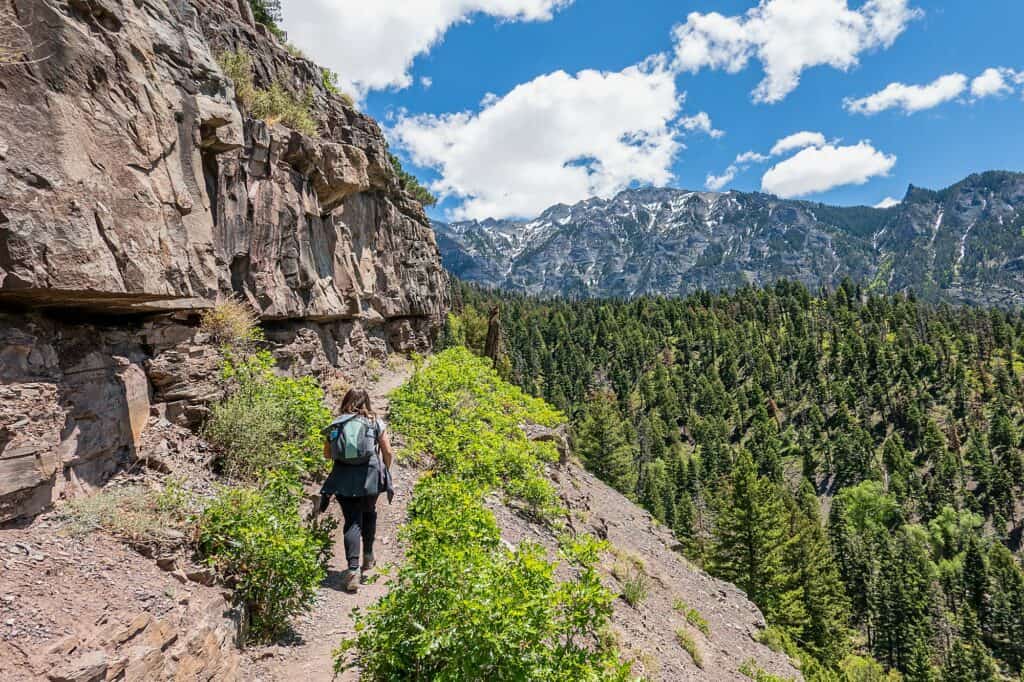Last updated on February 18th, 2025 at 10:27 pm

Have you been considering getting into hiking? Fantastic! If you’re looking for tips on hiking for beginners, you’ve come to the right place!
Hi, I’m Cindy! I’m an RVer and experienced thru-hiker who has devoted much of my time to exploring trails. Hiking is one of my favorite ways to connect with nature, get exercise, and enjoy the outdoors!
So much so that In 2022, my husband Barrett and I decided to hike the entire Appalachian Trail!
But if you’re brand new to hiking, I realize it’s hard to know where to start.
The prospect of venturing into the wilderness can be intimidating. Sometimes, it seems like everyone else already knows the ropes!
That’s why I put this guide together. I want to help first-time hikers feel more knowledgeable by giving concrete advice and helpful tips on hiking for beginners.
We’ll go over everything you should know, including how to find the best trails, choose the right hiking gear, safety tips, and everything you should do before hitting the trail!
What is Hiking?
Hiking is basically walking for pleasure. This can be in any natural setting, like the beach or countryside. However, people often associate hiking with the mountains.
The other thing that defines hiking is following a designated trail.
You might hear people interchange hiking with trekking or backpacking, but they aren’t exactly the same.
Hiking typically refers to a shorter distance that can be done in a day or two.
Backpacking is a more extended adventure where you spend more time hiking and camping off the grid.
Trekking (a.k.a. Thru-Hiking) is even more demanding and involves hiking extended distances for weeks or months. A great example is the Appalachian Trail.
Is Hiking Safe for Beginners?
Yes, absolutely! Hiking is very safe for beginners.
To ensure your safety, follow the advice below to pick the best trail for your abilities and arrive adequately prepared for the day.
The Bureau of Land Management (BMO), National Park Service, and Forest Service create loads of hiking trails that are accessible to the public.
They often create and maintain easy trails throughout the US geared towards families with small children, first-time hikers, and people who want to expel less energy to reach a scenic view.
Before You Start Hiking
Before getting to the trailhead, you’ll need to choose the right trail (according to your fitness level), familiarize yourself with some hiking lingo, and pick up some hiking gear.
Determine Your Initial Fitness Level

Many beginner hikers ask me, “Do you need to be fit to go hiking?”
The answer is…yes and no.
You don’t need to be an elite athlete to start hiking, but to be safe and – most importantly – enjoy yourself, you should choose a trail that matches your fitness level.
You should pick an easy trail with little elevation if you rarely exercise.
But if you work a physically demanding job, play sports, or exercise regularly, you’ll likely be comfortable with an easy or moderate trail.
If you want to attempt a trail with a ‘hard’ difficulty, you should have some previous hiking experience.
‘Hard’ trails can be rather challenging, even for people who’ve been hiking their whole lives.
How to Physically Train for Hiking
Honestly, the best way to train for hiking is to simply start hiking!
Practice on small trails near your home and gradually work your way up to longer routes. But if you live in the city and don’t have trails with much elevation, you can still prepare at home or the gym.
The most important thing to remember when training for hiking is that it’s not all about cardio.
That’s a piece of the puzzle, but hiking also involves a lot of strength.
You should include lower body strength and core exercises in your training to build the proper muscles to help with elevation gain and carrying a backpack for a few miles.
In addition to building muscle, many people recommend including mobility exercises in your training to help with your range of motion, improve balance, and prevent injury.
Learn about Elevation Gain
Elevation Gain is the total amount of feet you will ‘go up’ on a given trail. So if you ascend 1000 feet, descend 500 feet, then go up another 200 feet, the elevation gain is 1200 feet (total elevation accumulated).
This is the part of hiking that really makes you stop and catch your breath. It also adds time to hike. The average hiking pace is 2-3 miles per hour, but you should add an hour for every 1000 feet of elevation gain.
Side Note: any trail that climbs more than 500 feet per mile is relatively difficult. It will feel like a constant incline, and your legs will be on fire!
How to Choose a Beginner Hiking Trail
When you start looking up hikes, you’ll notice that most official hiking trails have a rating of easy, moderate, or hard.
Easy hikes usually have minimal elevation gain and are less than 5 miles. These trails are great for anyone, including kids, older hikers, and people not in peak physical shape.
Moderate hikes are slightly more challenging. They tend to be between 5 and 8 miles long and sometimes have a couple of thousand feet of elevation gain. Beginner hikers should only attempt a moderate hike if they live an active lifestyle and exercise a few times weekly.
If you’re new to hiking, choosing a trail with little elevation gain in the 2-4 mile range is best.
Also, be sure to read reviews of the trail ahead of your hike to ensure there has been no recent damage you should be aware of.
Where to Find Beginner Hiking Trails
You can find beginner hiking trails all across the United States and beyond.
You can search for hiking trails in your area on AllTrails. They have one of the largest databases for trails, and it’s a great place to search for hiking trails within the US and abroad.
There’s even an App with trail maps, information, and tons of user reviews so that you can read about people’s experiences and learn more about if it’s the right hiking trail for you! I also love AllTrails+, which allows me to download the maps for offline use.
Some other options include:
⛰️ PeakVisor
⛰️ Hiking Project
⛰️ National Park Service
⛰️ Physical Guidebooks
How to Choose Hiking Gear for Beginners
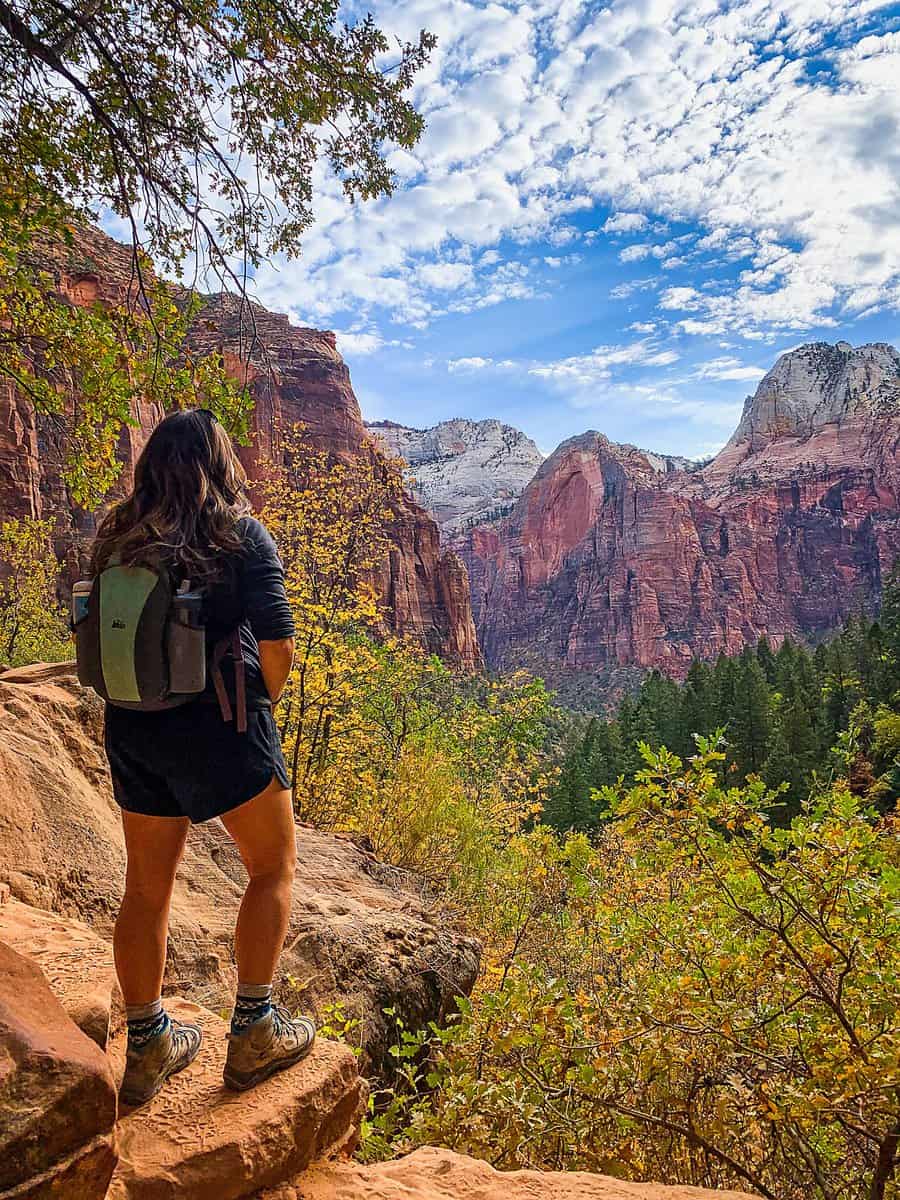
If you’re only going on a short day hike, you don’t need to purchase a bunch of new, expensive gear.
However, there are some clothing items and shoes that will undoubtedly make hiking safer and more comfortable.
What Clothing to Wear Hiking
While hiking, you’ll likely sweat, so I suggest wearing comfortable, breathable, lightweight clothing.
Avoid jeans or cotton T-shirts, which absorb sweat and become uncomfortable as you hike.
Pants are also much better than shorts since they protect your legs from poison ivy, scratchy brush, and bugs.
Also, it’s best to wear layers, especially during cooler months. While hiking, you can take off layers as you start to sweat, then put them back on when you take a break or reach the peak of a mountain!
Hiking Top
When specifically searching for a hiking top, a favored choice is to find a shirt that wicks away moisture and odor. Here are two of my favorites:
Women’s Smartwool Merino Sport 150 Hoodie
- WARM WEATHER APPAREL. This hoodie fabric combines the thermoregulation of ZQ-certified Merino wool with the quick dry times of Tencel performance fabric to create a lightweight performance fabric that helps you keep cool when your activity heats up.
Outdoor Research Women’s Echo T-Shirt
- SUN PROTECTION CLOTHING FOR WOMEN: Featuring eco-friendly mesh fabric with a stretch fit, this Outdoor Research T-shirt helps keep you cool and dry in hot weather. Its ultralight construction offers you enhanced comfort, movement, and fit.
👉 See more advice on hiking clothing here in my AT gear list.
What Footwear is Best for Hiking
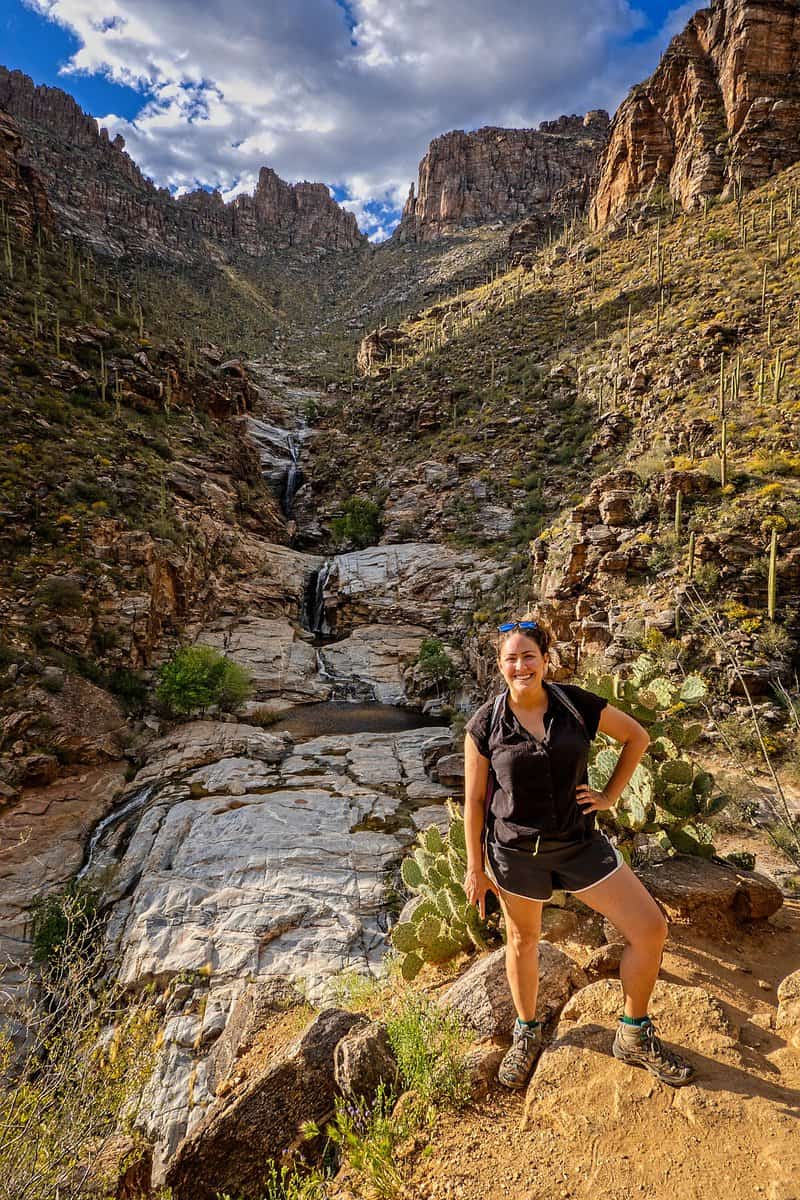
At the root of it, you need something durable with good tread. Most hiking trails aren’t paved, and the forest service does its best to mimic the natural surroundings so that you feel like you’re genuinely in nature.
That means walking on uneven dirt, sand, or rocky surfaces.
What specific shoe will work best for you is different for everyone. That said, running shoes, regular sandals, or flip-flops offer little support, making it easy to scrape your foot on a rock or twist an ankle.
Hiking boots or trail runners are ideal, but you can get away with a sturdy pair of tennis shoes or hiking sandals (like Tevas or Chacos).
If you’re unsure which style or brand will best fit your feet, I recommend buying your shoes at a place with a good return policy (such as REI); that way, you can break them in on a few short test hikes before fully committing to the shoe.
Trail Runners
Trail runners are admired by distance hikers since they are lightweight, breathable, and dry fast. Here are some popular options:
Topo Athletic Women’s Traverse Shoe: Amazon | REI
- TOPO ATHLETIC Womens Traverse, Color: Grey/Blue, Size: 8 (W059-080-GRYBLU)
Topo Athletic Men’s Traverse Shoe: Amazon | REI
- BUILT TO LAST - The Topo Athletic Men's Traverse Shoes are designed to endure the toughest trails and extended hikes. These shoes will stand up to the challenge, giving you both comfort and performance in one versatile package
Topo Athletic Women’s Ultraventure Shoes: Amazon | REI
- OPTIMAL CUSHIONING AND COMFORT - Topo Athletic Women's Ultraventure 4 running shoe is designed with a 35 x 30 mm platform, featuring a ZipFoam midsole. This unique construction ensures a comfortable and responsive ride, ideal for long runs on mild to moderate terrain
Topo Athletic Men’s Ultraventure Shoes: Amazon | REI
- OPTIMAL CUSHIONING AND COMFORT - Topo Athletic Ultraventure 4 running shoe is designed with a 35 x 30 mm platform, featuring a ZipFoam midsole. This unique construction ensures a comfortable and responsive ride, ideal for long runs on mild to moderate terrain
Women’s HOKA One One Speedgoat: Amazon | REI
- Synthetic mesh upper offering maximum breathability
Men’s HOKA One One Speedgoat: Amazon | REI
- Textile, Synthetic
Altra Women’s Lone Peak Trail Running Shoe: Amazon | REI
Altra Men’s Lone Peak Trail Running Shoe: Amazon | REI
- Get Comfortable : Signature Altra Balanced Cushioning and FootShape toe boxes allow your toes to spread and encourages proper, low-impact form throughout your run
👉 Read more about hiking footwear here in my AT gear list.
Hiking Boots
However, if you’d like to start with more support, stability, and protection, hiking boots would be great for you!
Socks
Hiking socks are another excellent item to purchase at a store with a fantastic return policy, such as REI. Buy a few pairs to test out on your hikes; you’ll discover what you love. That said, these are fan favorites for hikers:
👉 See more advice on hiking socks here in my AT gear list.
What Gear is Essential to Bring for Beginning Hikers
The Ten Essentials
When you hear hikers talking about the ten essentials, this is what they mean:
🧭 Navigation Items: Maps, guidebooks, a compass, and a GPS system if you choose to bring one.
☀️ Sun Protection: Sunscreen, sunglasses, and a hat or visor.
🔦 Light Source: Headlamp or Flashlight.
⛑️ First Aid: Have a first aid kit and be aware of how to use it.
🥪 Food: Snacks or Meals
💧 Water: Enough water for your hike and water treatment options.
🧤 Warmth Insulation: Ensure you have layers appropriate to the temperature you’ll encounter on your hike. Consider bringing a jacket, hat, gloves, rain jacket (or poncho), and wearing thermal underwear.
🔥 Fire: Have fire starter options such as matches or a lighter.
🛠️ Multitool: A small multitool that includes a knife, screwdriver, and scissors can be super helpful to have on hand, just in case. (A tiny roll of duct tape doesn’t hurt either.)
⛺️ Emergency Shelter Option: Mylar Blanket or Emergency Bivvy.
It’s fairly easy to carry lightweight versions of all the above items while hiking, giving you fantastic peace of mind when starting out.
Other Important Gear Items for Beginners to Consider
Trekking Poles
Trekking poles are great for adding stability to your hike. They also reduce swelling in your hands, can be used to gently push overgrowth aside, and can even help with scaring away black bears by banging them together.
When purchasing trekking poles, you’ll see male and female options. But it doesn’t really matter. Just make sure the one you pick feels good in your hands and that its length is a good fit for your height.
Cell Phone
Your cell phone is an immensely valuable tool for hiking. To get the most use out of it, be sure to download the offline version of your destination’s map beforehand.
What to Look for in a Daypack
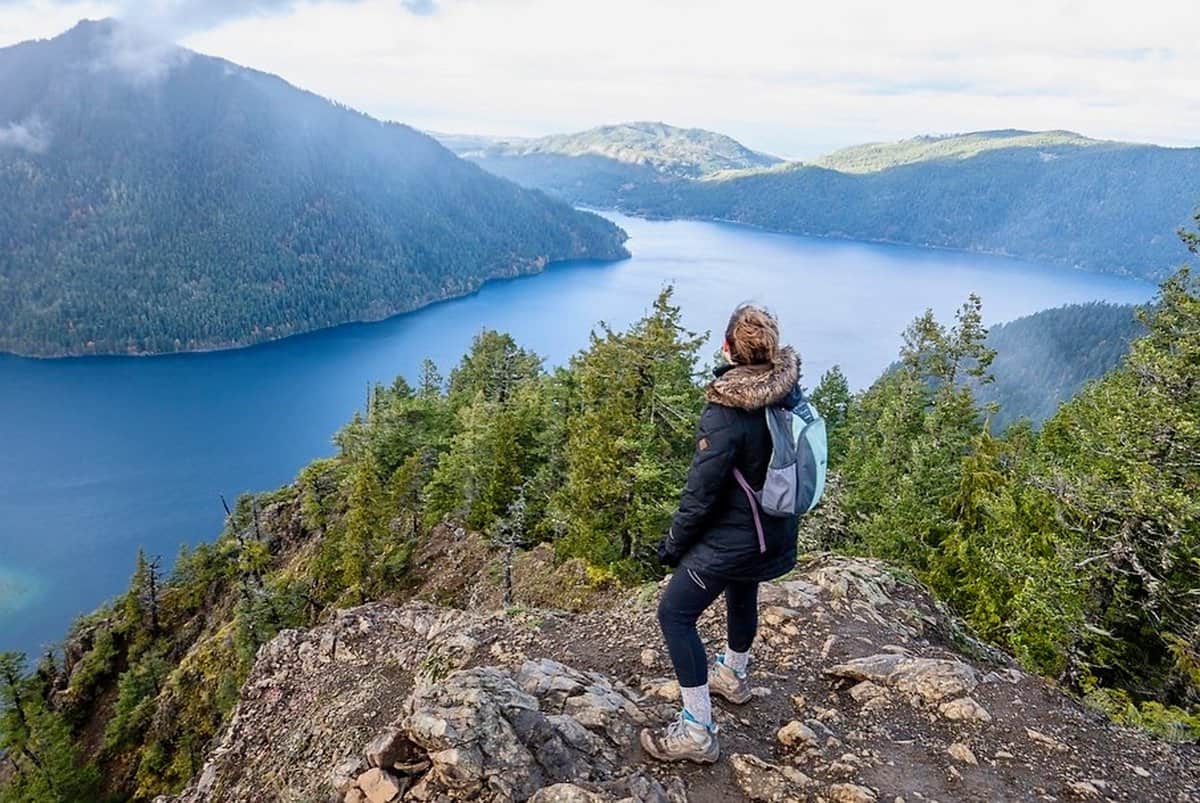
You’ll want a good daypack to hold all the above items while hiking.
Try on different packs and see which is the most comfortable for you. 15 to 30 liters is a popular carrying capacity for daypacks.
Also, depending on how you want to carry your water, look for one with easily accessible side pockets to hold your water bottle or an internal compartment for your hydration pack.
Hip belts are also a functional addition for quickly getting to snacks and cell phones.
Before You Head On Your First Hike
Once you have all your gear and have chosen a hiking trail, you’re almost ready to go!
That said, extra research and prep before your first hike will greatly impact your experience.
Here are the final things to double-check before you hit the trail.
Consider the Season
While you can hike all year round, the experience changes drastically based on the season. Some seasons are much better than others, depending on where you are, and certain hikes are only accessible during certain months of the year.
☀️ Summer: The most reliable weather, but it also means blistering heat throughout southern states and more bugs in the mountains.
🍁 Fall: This is probably my favorite time to go hiking. I love the fall foliage and cooler temperatures, but crowds are higher. Some parts of the Appalachian trail are wildly popular, with day trippers from the Carolinas and Northeast US coming to see the colors.
❄️ Winter: The colder months are an underrated hiking time, but you will likely need to bundle up. Also, some trails will be completely closed or ‘snowshoe-only.’
🌸 Spring: This season is full of wildflowers and cooler temperatures. However, the trails can be muddy, and high-elevation roads might still be closed to the public.
Check Weather Conditions
You should also check the weather forecast a couple of days before you head out and plan to go hiking for a day with little chance of rain or storms and relatively comfortable temperatures. Getting caught in a downpour or a heatwave can ruin even the most beautiful day hikes.
If there’s even a slight chance of rain, I highly recommend carrying a poncho or rain jacket in your backpack and getting a rain cover for your daypack.
- WATERPROOF – 100% waterproof, seam taped, lightweight and durable non woven Polypropylene material perfect for year after year use. PFAS free, no forever chemicals in materials or production
- Made with Frogg Toggs breathable, waterproof, wind-resistant, and lightweight material
- Ultralight pack cover for keeping a backpack dry when hiking, backpacking, or traveling
You’ll also want to note if it’s an especially hot day.
Summer heat waves are common in certain states, such as Arizona, Utah, California, and Texas. If it’s supposed to be extra hot or has a UV rating of 7+, you should bring extra water, sunscreen, and a hat to protect your face from the sun.
If it’s supposed to be unusually hot, assess whether you should go out in those temperatures. If you decide it’s okay, still bring extra water.
Check Trail Conditions
The final thing to do before heading out on your journey is to check the trail conditions. If your hike is located at a park with a Visitor Center, the most reliable thing to do is ask a local ranger.
They can give you the most up-to-date information on the trails around the park.
But if you don’t have access to a local ranger, hiking apps like AllTrails offer reviews for each hike. People are pretty active on this forum, so I can usually find recent reviews talking about the state of the trail. People talk about everything from fallen trees, water levels, washed-out paths, trail closures, and even mention recent animal sightings.
All this helps you know what to expect and better prepare for your hike. No one wants to start a hike and discover halfway that the path is a no-go.
(It has happened to us, and it turned what we thought would be a 21-mile backpacking loop trip into a 27.5-mile out-and-back trip!)
During Your Hike
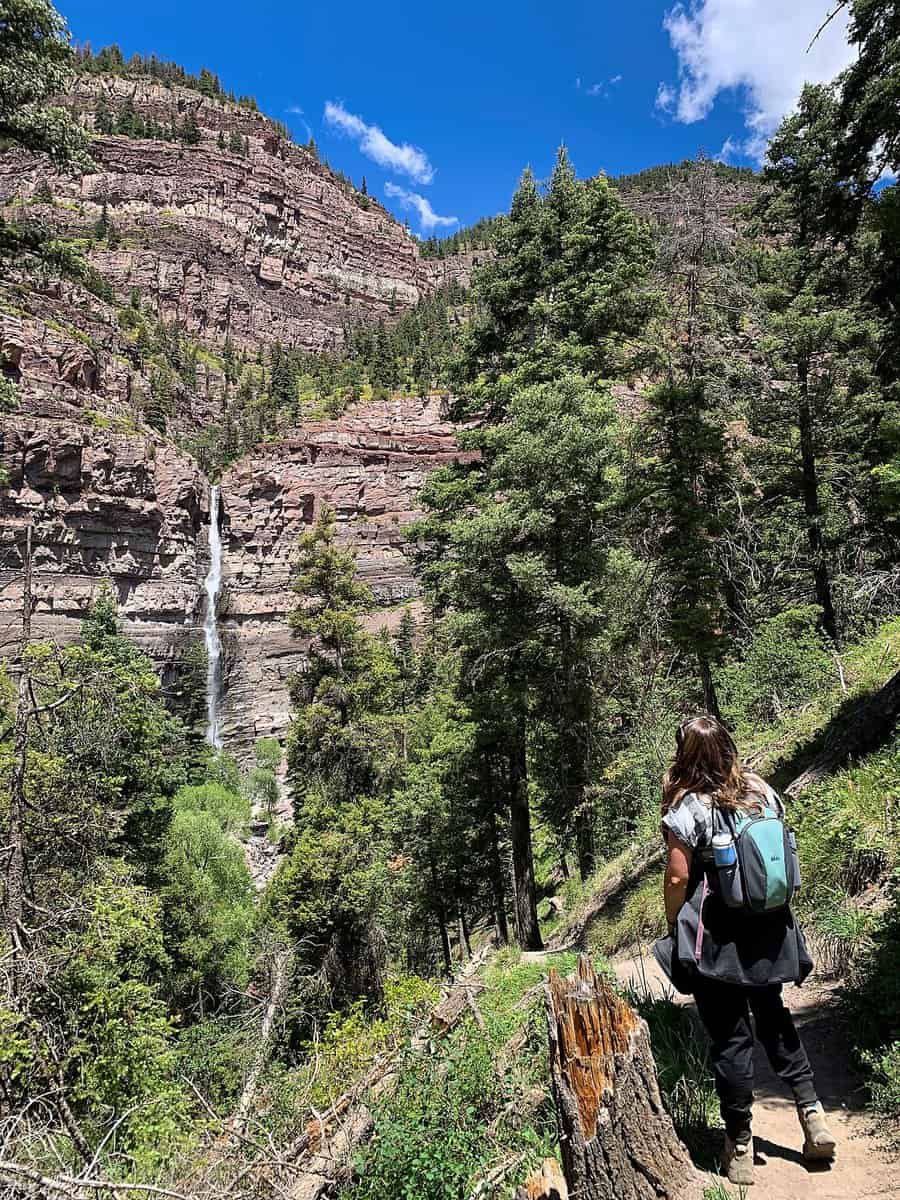
While enjoying your hike, it’s necessary to remember proper etiquette, leave no trace principles, and how to best stay safe.
Be Sure to Use Proper Trail Etiquette
Most trail etiquette involves respecting other hikers and creating an enjoyable experience for everyone on the hiking trail that day. Honestly, even experienced hikers can forget the basics.
Here is a list of the 5 essentials of proper trail etiquette.
- Uphill hikers have the right of way.
- Don’t disturb the sounds of nature. Keep your voice low, and don’t play loud music. Hikers usually go to nature to escape from the business of society, so do your best to keep the environment peaceful.
- Move to the side when taking a break.
- Groups should walk single file. This is specific for group hikers.
- Keep dogs on a leash.
All these tips concern respecting other hikers so everyone can enjoy the trail.
Be Sure to Follow the Leave No Trace Principles
While hiking, you may have heard people say ‘Leave No Trace’ and wondered what it means.
The phrase is a catch-all for respecting nature and protecting the environment, similar to “Take only pictures, leave only memories.”
The most obvious way to do this is to pick up after yourself (and your pets). You should take everything you bring on the hike back out with you, especially trash.
But it’s also essential to stay on the trail. Some of the vegetation growing in the forest is fragile, and one wrong step can ruin it.
Also, refrain from touching/feeding wildlife, taking rocks, picking flowers, or disturbing nature in any other way.
Learn more about Leave No Trace here.
Tips on How to Stay Safe While Hiking
When hiking – especially solo hiking – it’s important to be safe on the trail. I’ve learned so much about trail safety over the years, so here’s my best advice.
First, always tell someone your planned route and when you expect to return. You can even get a Satellite Communicator, which allows hikers to send a message, see your location, and notify authorities in an emergency. They’re expensive but can be an excellent helpline when you don’t have cell service.
- Compact, lightweight satellite communicator enables two-way messaging and interactive SOS globally (Active satellite subscription required. Some jurisdictions regulate or prohibit the use of satellite communication devices.).Special Feature:Bluetooth.Water Resistant: Yes
Also, since many trailheads and trails don’t have cell service, I always encourage new hikers to download maps and any other digital guides before they get to the trailhead.
Another thing to consider is self-defense gear. If you’re in bear country, carry bear spray.
- MAXIMUM STOPPING POWER: Strongest formula allowed by law (EPA Requires range of 1.0-2.0% Major Capsaicinoids), Frontiersman bear spray, made with 2.0% Major Capsaicinoids, is backed by our industry exclusive in-house HPLC lab, guaranteeing maximum strength in each canister
Carry pepper spray and a Birdie (personal safety alarm) if you’re hiking alone. It’s always better to have it and end up not needing it.
- TRUST THE PROFESSIONALS: SABRE is the #1 Pepper Spray brand trusted by police and consumers worldwide, including New York PD, Chicago PD, and U.S. Marshals; Made in the USA
Lastly, pack more food and water than you think you’ll need. I’d rather come back with a little extra than be lightheaded and short on food.
Extra Tips
Here are a few more hiking tips:
Conquering Hiking Fears
There are three general fears that I have often come across that are preventing people from hiking.
First, people are nervous about getting lost. The truth is that if it’s your first time hiking, you probably aren’t going deep into the backcountry, so you don’t have much to worry about. Popular trails in a National Park or State Park are easy to follow and have signs along the way.
Chances are you won’t be the only one on the trail, either. Other hikers are super friendly! So, anytime you’re concerned, stop and confirm with another hiker that you’re on the right path.
The next biggest fear is wildlife (particularly bears). In general, wildlife are much more scared of you than you are of them. In my experience, no animal wants anything to do with you unless threatened. If you encounter wildlife, the best advice is to keep a safe distance.
Finally, some female hikers become concerned about other hikers as a threat. As a woman, I understand that concern. That’s one of the reasons it’s important to bring a Birdie and some form of self-defense (pepper spray is perfect).
- When threatened, activate Birdie's LOUD siren and flashing strobe-light to create a diversion and to help deter an attack.
That said, I have found it’s unlikely another hiker will bother you, and you can mitigate a lot of risk by hiking with a buddy or group.
Always trust your intuition, but coming to the hike fully prepared will make it feel much safer!
Hiking with Children
Hiking with your kids can be an amazing experience. It’s a great way to bond with your kids and foster a love for the outdoors, but it’s normal to be nervous about it.
If your kids are under two years old, you’ll want a carrier for them.
Softshell carriers are best for newborns and babies under six months.
Then, once they are older than six months, you can use a hard-shelled, rigid carrier backpack.
- Premium efficiency and design
Be sure to bring extra snacks and plenty of sunscreen. Dress your toddlers in comfortable, lightweight clothes, and always start with short, easy trails close to home. These mini-adventures are perfect for little legs and short attention spans.
Keep your expectations low and your plans flexible since you never know what your kids will be up for on a given day.
Hiking with Dogs
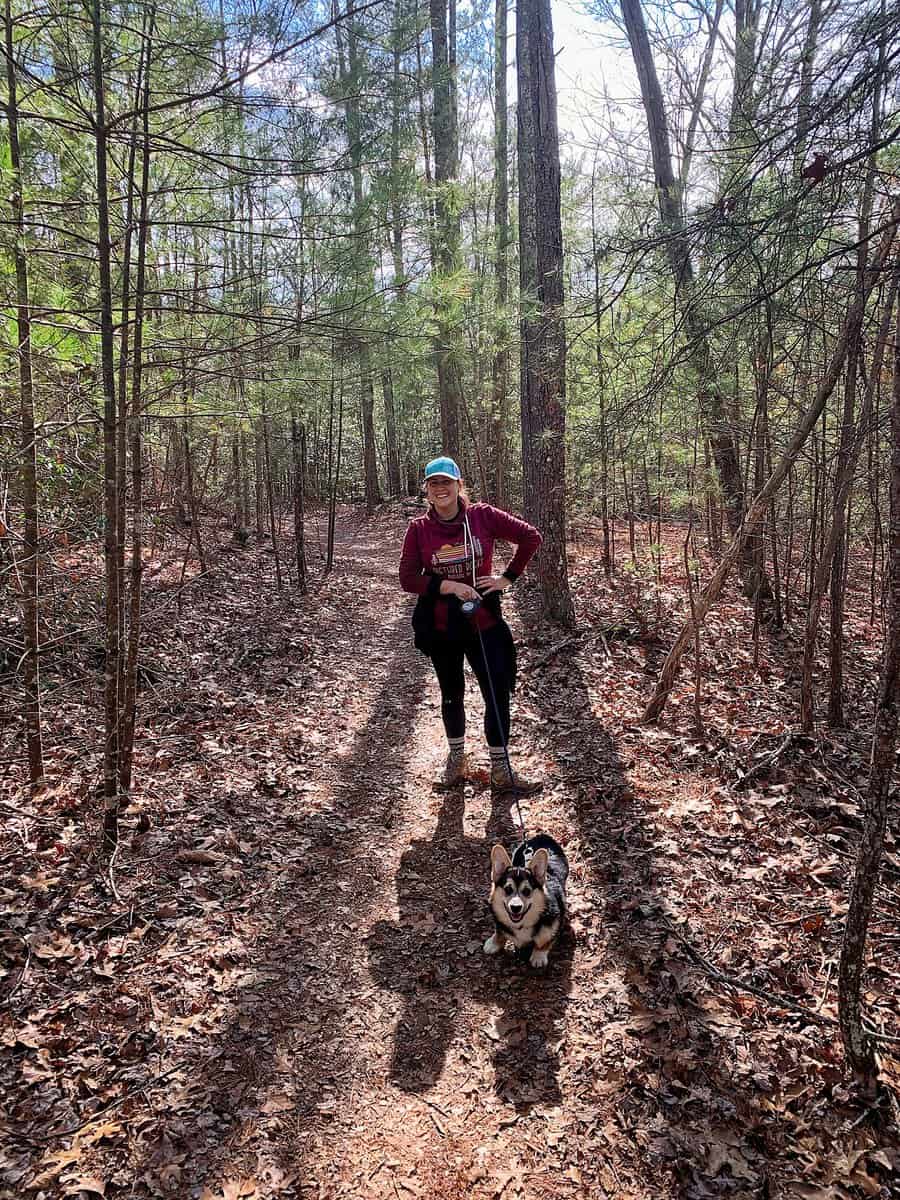
My husband and I lived in an RV with our pets for three years, and I loved bringing my dog along for hikes whenever possible.
Hiking with a dog is very similar to taking them to a park. You’ll want to ensure the trail is dog-friendly, bring waste bags, keep them on a leash, and bring plenty of water for both of you.
- DOG POOP BAGS: Our durable poop bags are a dog-walking essential. They are extremely portable and pair perfectly with the Earth Rated Poop Bag Dispenser for easy access while on the go.
- 【BIG TROUGH & RECOVER UNUSED WATER】➊ This dog cat travel water cup bowl has 2.8 inches Big Trough. It not only ensure dog drinking water easily but also cat, rabbit or other small pet to drinking water quickly, moreover doesn't Wet Your Dog. ➋ In addition, a most important and different point is that puppy bowl press button to re-collect the remaining water and use it again. Protect water resources without wasting a drop of water.
You’ll also want to start slowly and let your pup build up stamina before tackling longer trails.
Starting slow also allows them to build up the padding on their paws to handle rough terrain.
Some people even buy their dog little hiking boots to protect their paws!
How to Handle Wildlife Encounters and Stay Safe
If you’re concerned about animal attacks, it’s helpful to know that they are rare on the trail and most often result from the hiker provoking an animal. But it’s better to be safe than sorry.
The best way to stay safe is to respect other animals’ space. Keep a safe distance, and if you see a deer, bear, or bison on the path ahead. Be extra patient and wait for them to move on before trying to pass them.
It also helps to carry bear spray in certain areas. Although it’s called bear spray, it works on any aggressive animal.
If you see a bear, the National Park Service has some tips on navigating the situation.
If you’re still nervous, hiking in a group is another way to prevent animal attacks. The sound of your conversation will prevent encounters, and animals are less likely to attack a group.
Solo Hiking vs Hiking with a Partner
Solo hiking simply means hiking alone. Some people love solo hiking, while others are slightly intimidated by it. If you don’t have a hiking partner who wants to join you for the hike, don’t let that keep you from hiking altogether.
Is it Safe to Hike Alone?
Taking a solo hike is safe as long as you follow all the safety precautions we discussed earlier in this post (e.g., tell someone where you’re going, bring pepper spray, download maps, etc.).
Where/How to Find a Hiking Buddy
When you first start hiking, most people don’t want to go alone for the first time. But if you don’t know anyone who likes hiking or are nervous about asking your friends, there are other ways to find a hiking buddy.
The best option is to join hiking groups. Most of these groups have free events that you can join, local meetups, and camping trips. They’re often completely free, too!
There are also female-specific hiking groups such as Women Who Explore, Outdoorsy Gals, and Girls Who Hike.
Another great option is to attend a workshop or event hosted by REI.
Would You Like to Hire a Guide?
While you don’t need to hire a guide for your first hike, some people feel more comfortable going with an experienced guide.
A guide can help you pace yourself, ensure you stay on the trail, and teach you more about the area. Guides are also excellent resources for learning about the local environment and history, enhancing your overall experience.
To find a guide, check with local hiking clubs or outdoor adventure companies, which often have certified guides for various skill levels and interests. Additionally, visitor centers at national parks offer guided hikes.
I’ve heard good things about Tours By Locals and REI’s Adventure Programs, too!

FAQs about Getting Started with Hiking
The following are questions that commonly come up when people are just starting to get into hiking:
What is Considered a Beginner Hike?
A beginner hike is typically an easy trail with minimal elevation gain, usually less than 5 miles long. These trails are ideal for those new to hiking, including families with children and individuals who might not be in peak physical shape.
How Far Can a Beginner Hike in a Day?
Generally, a beginner can comfortably hike between 2 to 5 miles in a day, depending on their fitness level and the trail’s difficulty. It’s important to start with shorter distances and gradually increase as you gain more experience and confidence.
How Long Does it Take to Hike 1 Mile?
On average, it takes beginners about 30 to 45 minutes to hike a mile on a relatively easy trail. However, if there is a lot of elevation gain or specifically challenging terrain, it could take longer!
How Many Miles Should a Beginner Hike?
Beginners should aim for a hike in the 2-5 mile range. This distance is manageable for most fitness levels and provides an excellent introduction to hiking without being overly taxing.
How Much Water Do I Need for a 5-Mile Hike?
For a 5-mile hike, it’s recommended to bring at least 1 to 2 liters of water. Hydration needs can vary depending on the weather, your exertion level, and your individual needs, so it’s always better to carry a bit extra.
Hiking with a resource to purify water is also optimal, so you are covered if you run out.
What if I Need to Go to the Bathroom?
You’ll often find bathroom facilities in the parking lot for short, easy hikes.
However, you should also be prepared for there not to be one. Every hiker eventually reaches a moment when they must use the bathroom in a space without a bathroom or privy.
Here are a few handy bathroom tools that make things easier:
Trowel
A trowel is a staple in every backpacker’s bathroom kit, and it is used to abide by the Leave No Trace principles and “dispose of waste properly. “
These trowels help you dig the necessary hole to bury your human waste, which should be deposited in a 6-8 inch cat hole 200 feet from all water sources, campsites, and trails.
- 𝗘𝗦𝗦𝗘𝗡𝗧𝗜𝗔𝗟 𝗦𝗨𝗥𝗩𝗜𝗩𝗔𝗟 𝗧𝗢𝗢𝗟 – The Vargo Dig Dig Tool is the ultimate addition to your survival gear tool kit. Its titanium construction makes cutting through dirt and roots a breeze. Explore with confidence knowing your equipment is up for the task.
Toilet Paper
TP for wiping your bum. Bring a ziplock with you so you can carry it out.
Pee Cloth
Pee cloths are an option for TP-less wiping.
They are absorbent cloths made of antimicrobial and anti-odor materials.
- ☘BE KIND TO THE ENVIRONMENT ON YOUR HIKING ADVENTURES: No more unpleasant wetness, odors and UTI that come from drip-drying after peeing outdoors! Our environment friendly pee cloth is small, travel size, discreet and easy to carry. Avoid carrying around and disposing rolls of toilet paper or wet wipes in hiking or camping areas. Practice leave no trace principles.
pStyle
I personally found the pee cloth grossed me out. To each their own.
I’m a big fan of this funnel that guides your pee out and away from you so you can pee like a man. (Not having to crouch is a fantastic added bonus!)
These are comfortable, easy to clean, and discrete to pee out of.
- PEE STANDING UP WHILE FULLY CLOTHED - Sturdy design of the pStyle female urination device is a cinch to maneuver through clothing - won't crumple and leak like flexible brands
Conclusion: Hiking for Beginners
For me, almost nothing compares to the high that comes from spending time in the great outdoors!
As an avid hiker and backpacker, I know that all of the above tips for getting started with hiking are important for making your trip as enjoyable as possible!
I hope this article has encouraged you to plan your first hiking adventure!
You May Also Enjoy:
👉 How to Plan a Backpacking Trip in 16 Easy Steps
👉 A Smoky Mountain Itinerary for Every Type of Traveler & Everything Else you Need to Know
👉 AT Thru-Hike: How Long Does It Take to Hike The Appalachian Trail?
- Hiking the Appalachian Trail: Week 3 Thru-Hike Journal - March 27, 2025
- Best Appalachian Trail Shoes for Long-Distance Hiking - March 4, 2025
- Backpacking Clothes for an Appalachian Trail Thru-Hike - March 4, 2025

